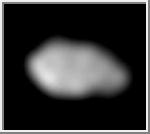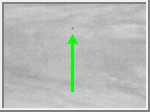













|
Metis [MEE-tis] is the innermost known satellite of Jupiter. It was named after a Titaness who was a consort of Zeus (Jupiter). Metis and Adrastea lie within Jupiter's main ring and may be the source of material for the ring. Very little is known about Metis.
| Views of Metis |
|---|
 Galileo Image of Metis
Galileo Image of Metis
This image of Metis was taken by Galileo's solid state imaging system between
November 1996 and June 1997. Although Metis was discovered by Voyager, it was
no more than a point of light on images. This Galileo image is the
the first image of the small moon that shows its irregular shape.
Metis orbits Jupiter in the zone between the planet's ring and the larger
Galilean satellites. The longest dimension of Metis is approximately 60
kilometers (37 miles) across.
(Courtesy of NASA/Cornell University)
 Metis
Metis
This image of Metis was taken by the Voyager 1 spacecraft
on March 4, 1979. Metis is the small dark dot above the arrow.
(Copyright Calvin J. Hamilton)
 Best images yet of Thebe, Amalthea and Metis
Best images yet of Thebe, Amalthea and Metis
These images of the inner Jovian moons Thebe,
Amalthea, and Metis (left to right) are the
highest-resolution images ever obtained of these small, irregularly
shaped satellites. The images resolve surface features as small as 2 kilometers
(about 1.2 miles) across for Thebe; 2.4 kilometers (about 1.5
miles) across for Amalthea, and 3 kilometers (about
1.9 miles) across for Metis.
The moons are shown in their correct relative sizes, with sunlight
coming from the right. We are viewing the side of each moon that
faces permanently away from Jupiter, and
north is approximately up in all cases.
(Courtesy NASA/Cornell University)
 Jupiter Small Satellite Montage
Jupiter Small Satellite Montage
This image is A montage of images of the small inner moons of Jupiter from
the camera onboard NASA's Galileo spacecraft shows the best
views obtained of these moons.
The top two images show the moon Thebe.
Thebe rotates by
approximately 50 degrees between the time these two images
were taken, so that the same prominent impact crater
is seen in both views; this crater, which has been given
the provisional name Zethus, is near the point on Thebe
that faces permanently away from Jupiter.
The next two images show the moon Amalthea; they were taken
with the Sun directly behind the observer, an alignment that
emphasizes patterns of intrinsically bright or dark
surface material. The third image from the top is a view of
Amalthea's leading side, the side of the moon that 'leads'
as Amalthea moves in its orbit around Jupiter. This image
looks 'noisy' because it was obtained serendipitously during
an observation of the Jovian satellite Io.
The fourth image from the top emphasizes prominent 'spots'
of relatively bright material that are located near the point on
Amalthea that faces permanently away from Jupiter. The bottom
image is a view of the tiny moon Metis.
(Courtesy NASA/Cornell University)
![]() Family Portrait of the Small Inner Satellites of Jupiter
Family Portrait of the Small Inner Satellites of Jupiter
These images, taken by Galileo's solid state imaging system between
November 1996 and June 1997, provide the first ever "family portrait"
of the four small, irregularly shaped moons that orbit Jupiter
in the zone between the planet's ring and the larger Galilean satellites.
The moons are shown in their correct relative sizes, with north approximately
up in all cases. From left to right, arranged in order of increasing distance
from Jupiter, are Metis (longest dimension is approximately 60 kilometers or
37 miles across), Adrastea (20 kilometers or 12 miles across), Amalthea
(247 kilometers or 154 miles across), and Thebe (116 kilometers or 72 miles
across). While Amalthea, the largest of these four tiny moons, was imaged
by NASA's two Voyager spacecraft in 1979 with a resolution comparable to what
is shown here, the new Galileo observations represent the first time that
Metis, Adrastea, and Thebe have been seen as more than points of light.
(Courtesy of NASA/Cornell University)
| References |
|---|
Synnott, S. P. "1979J3: Discovery of a Previously Unknown Satellite of Jupiter." Science, Vol 212, 19 June 1981.
Synnott, S. P. "Orbits of the Small Inner Satellites of Jupiter." Icarus 58, 1984.
Copyright © 1997-2000 by Calvin J. Hamilton. All rights reserved. Privacy Statement.